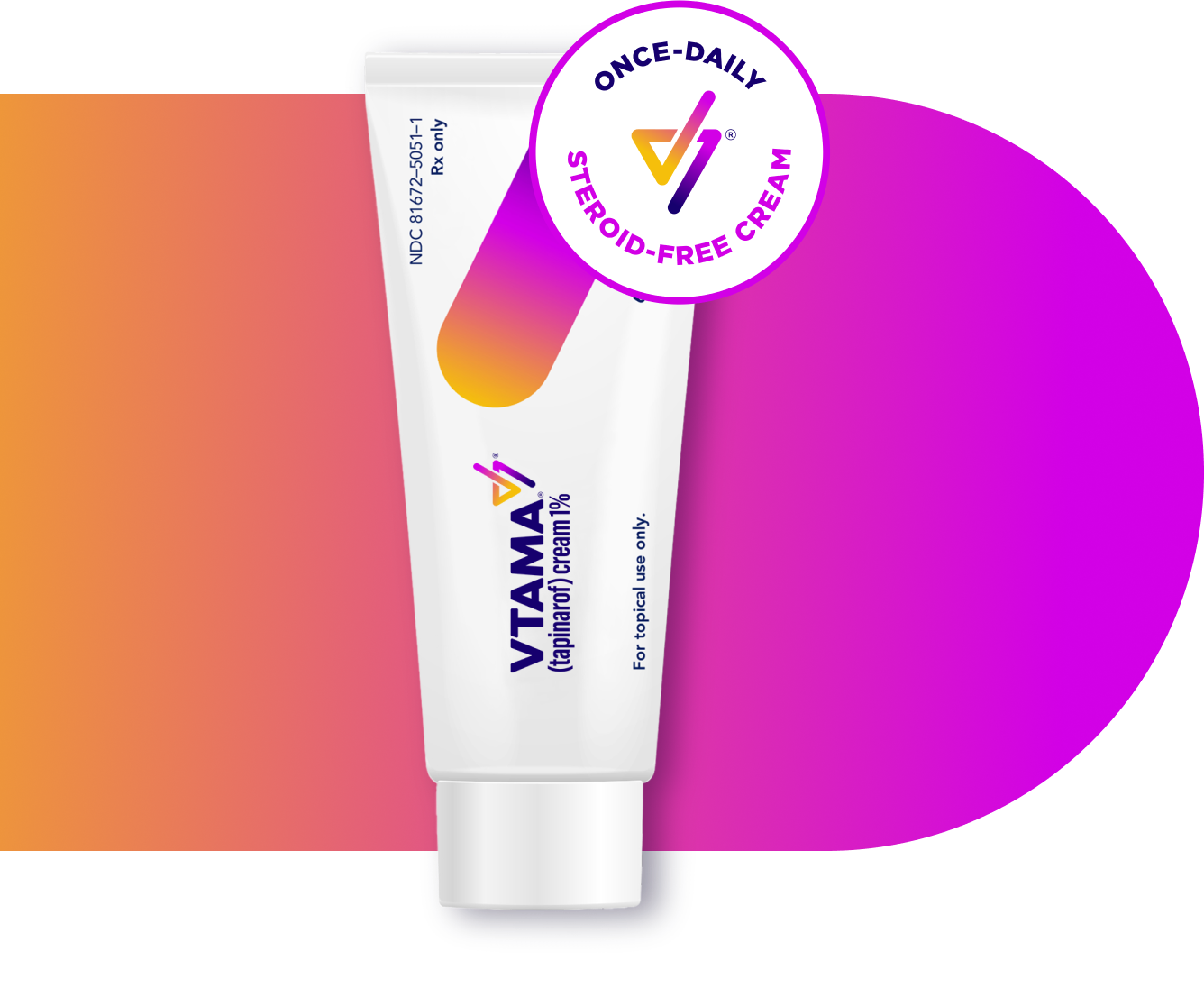


Apply a thin layer of VTAMA cream only to your eczema once daily. Hold the tube upright when dispensing cream.
Avoid applying to unaffected areas of your skin.
Wash your hands after applying, unless you are using it to treat your hands.
If someone else applies VTAMA cream for you, they should wash their hands after application.
VTAMA cream is for use on the skin (topical use) only. Do not use VTAMA cream in your eyes, mouth, or vagina.
Talk with your healthcare provider if you have questions about how to use VTAMA cream with moisturizers or cosmetic products.

Gain access to a wealth of resources tailored to help you manage your eczema.
VIP Updates Terms of UseEczema, also known as atopic dermatitis or AD, is a chronic disease characterized by dry, itchy, inflamed skin with unpredictable flares. Eczema predominantly affects children, and the prevalence is only increasing. About 13% of children in the US have eczema, and it most commonly appears as dry, itchy patches on the face or neck, and in the folds of the elbows or knees.
Your healthcare provider can determine whether you or your child have eczema and what the best treatment option is.
VTAMA cream is a once-daily, steroid-free, prescription treatment for eczema that is approved by the FDA for adults and children as young as 2 years of age.
VTAMA cream can be used by anyone diagnosed with eczema who is 2 years of age or older who has been prescribed VTAMA cream.
Apply VTAMA cream once daily around the same time every day. You may choose the time of day that works best for you to apply VTAMA cream. For instance, you may feel it’s best to use it in the evening or before bedtime.
VTAMA cream is for use on the skin (topical use) only. VTAMA cream can even be used on affected sensitive skin areas, like your face and neck, armpits, chest/breasts, groin, and genitals. Do not use VTAMA cream in your eyes, mouth, or vagina.
Use VTAMA cream exactly as your healthcare provider tells you to use it.
Apply a thin layer of VTAMA cream only to your eczema one (1) time a day. Avoid applying VTAMA cream to unaffected areas of your skin.
Wash your hands after applying VTAMA cream, unless you are using it to treat eczema on your hands.
If someone else applies VTAMA cream for you, they should wash their hands after application.
Talk with your healthcare provider if you have questions about how to use VTAMA cream with moisturizers or cosmetic products.
In two primary studies investigating VTAMA cream, up to 46% of patients (374 out of 813) using VTAMA cream reached clear or almost clear skin* in 8 weeks compared to 18% using a cream with no active ingredient. ~82% of patients (594 out of 728) entered with or achieved clear or almost clear skin at least once while using VTAMA cream in a 48-week open-label clinical study.
You may also experience itch relief, as reported in the pivotal studies by some patients, in as early as 2 days.
*Patients also achieved a ≥2-grade improvement from baseline in vIGA-AD score in 8 weeks.
Learn more about the results you could achieve with VTAMA cream.
The most common adverse reactions (incidence ≥1%) in patients with atopic dermatitis treated with VTAMA cream were upper respiratory tract infection, red raised bumps around the hair pores (folliculitis), lower respiratory tract infection, headache, asthma, vomiting, ear infection, pain in extremity, and stomach-area (abdominal) pain.
Don’t worry! Apply as soon as you remember if it’s still close to when you usually use it. If it’s almost time for the next application, wait until then. Do not double the dose or use more than once daily. Continue treatment the next day like usual and use VTAMA cream as your healthcare provider instructed.
If you are having trouble keeping track of when to apply VTAMA cream, consider setting a reminder to help.
Yes. VTAMA cream is a prescription medication. Talk to your healthcare provider about whether VTAMA cream is right for you.
MyVTAMA is the patient support program from Organon. It was created to give you support and assistance along your eczema treatment journey.
Organon is committed to making VTAMA cream accessible and affordable to commercially insured patients* with eczema. With the MyVTAMA savings card, commercially insured patients may pay as little as $0 and no more than $35.
If you have any questions regarding your eligibility or benefits, call 844-674-3200 (8:00 AM–7:00 PM ET, Monday–Friday).
*Eligibility required. This offer is invalid for patients whose prescription claims are eligible to be reimbursed, in whole or in part, by any governmental program.
Additional resources include the Patient Brochure and Doctor Discussion Guide, a questionnaire to help you prepare for appointments with a healthcare provider and get the most out of them.
VTAMA cream should be stored at room temperature, between 68°F to 77°F (20°C to 25°C).
It should not be frozen or exposed to excessive heat. Keep VTAMA cream and all medicines out of the reach of children.
Indications: VTAMA® (tapinarof) cream, 1% is an aryl hydrocarbon receptor agonist indicated for:
Adverse Events: In plaque psoriasis, the most common adverse reactions (incidence ≥1%) were: red raised bumps around the hair pores (folliculitis), pain or swelling in the nose and throat (nasopharyngitis), skin rash or irritation, including itching and redness, peeling, burning, or stinging (contact dermatitis), headache, itching (pruritus), and flu (influenza).
Adverse Events: In atopic dermatitis, the most common adverse reactions (incidence ≥1%) were: upper respiratory tract infection, red raised bumps around the hair pores (folliculitis), lower respiratory tract infection, headache, asthma, vomiting, ear infection, pain in extremity, and stomach-area (abdominal) pain.
You are encouraged to report negative side effects of prescription drugs to the FDA. Visit www.fda.gov/medwatch or call 1-800-FDA-1088.
Please read the Prescribing and Patient Information for VTAMA cream and discuss it with your doctor.
 Back to top
Back to top
